Aperture's Blog, page 167
January 16, 2015
Aperture Congratulates LaToya Ruby Frazier
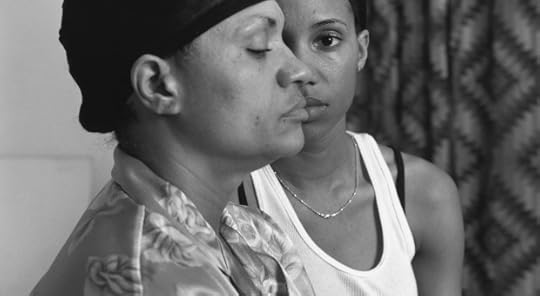
LaToya Ruby Frazier, whose The Notion of Family was published by Aperture in 2014, has had a remarkable year. Along with being awarded a 2014 John Simon Guggenheim Memorial Foundation Fellowship, TED named her aSenior Fellow for 2015 in December; she will appear this year at TED2015, from March 16 to 20 in Vancouver. She has also been selected as a 2014 United States Artist Fellow. The Notion of Family is Frazier’s first book, and offers an exploration of the legacy of racism and economic decline in America’s small towns, as embodied by her hometown of Braddock, Pennsylvania. The work also considers the impact of that decline on the community and on her family, creating a statement both personal and truly political—an intervention in the histories and narratives of the region. Frazier has compellingly set her story of three generations—her Grandma Ruby, her mother, and herself—against larger questions of civic belonging and responsibility.
Click here to read more about The Notion of Family.
The post Aperture Congratulates LaToya Ruby Frazier appeared first on Aperture Foundation NY.
January 15, 2015
Joe Purdy Visits Aperture (Video)
Joe Purdy stopped by Aperture to check in with executive director Chris Boot following his performance with photographer Alec Soth and musician Billy Bragg at our Aperture Open Road Benefit Party and Auction in October. For the multimedia performance, the three traveled along the Rock Island Line with filmmaker Isaac Gale, playing music and photographing along the way.
As they travelled, the group played impromptu shows, performing at each place they stopped, including a benefit held outside of Ferguson, Mississippi. Of the trip, Purdy recalls, “It’s been really inspiring and has sent me on a task of being less lazy as a person. . . . The people and the issues that we found in America have started to really influence my work. You could call it a political stance, but I just think of it more as a human stance.”
The group plans to continue traveling and performing together in 2015.
The post Joe Purdy Visits Aperture (Video) appeared first on Aperture Foundation NY.
January 14, 2015
David Solo on The Grand Tour: A Photobook Travelogue
As a collector, enthusiast, and supporter of photo- and artist books, I want to see and learn as much as I can about what’s being created now, as well as about books from the past. It seems like there are two or three photobook fairs, festivals, or other events nearly every weekend—especially in Europe—so there are lots of opportunities. While it’s certainly possible to find photobooks online these days (and I do), it still doesn’t compare with the fun of handling them; talking to the folks who make, study, sell, and collect them; and adding a few to the collection. Apart from when it’s time to pack the new acquisitions (and when my luggage hits the scales at check-in), it’s a pleasure. Here are a few of my highlights from the past six months:
Stray Books Festival, London, June 2014:
A mini festival held outdoors at Red Gallery and organized by Valentina Abenavoli and Alex Bocchetto of Akina Books. With a focus on self-publishing, the majority of tables were run by artists—a welcome change from larger publisher/seller-driven fairs. There was a very strong selection of material here I hadn’t seen before. straybooks.wordpress.com
Bushwick Art Book and Zine Fair, Brooklyn, June 2014:
The most recent incarnation of Sonel Breslav’s (of Blonde Art Books) event of mostly local artist- and writer-produced books and zines was held this year at SIGNAL, and included a number of interesting photobooks from the folks at Miniature Garden and NoWork. blondeartbooks.com
Kaleid 2014, London, July 2014:
The third installment of this curated event, organized by Victoria Browne, brought together artist-made books from Europe and included the launch of Liane Lang’s photobook object/project. The presence of photobooks at Kaleid has expanded and it’s a great forum to meet with most of the artists involved. kaleideditions.com
Megutama, Tokyo:
Not technically a book “event,” Megutama is remarkable nonetheless. This new cafe in Tokyo has a library of several thousand photobooks, available for browsing while you’re dining. megutama.com
Asia-Pacific Photobook Archive at RayKo Photo Center, San Francisco, August 2014:
A tweet one morning announced that the start of the Asia-Pacific Photobook Archive’s U.S. tour would take place in San Francisco that afternoon. I happened to be there, and it was a delight to see a number of books I didn’t know and meet both the folks from RayKo and from APPA, an Indie Photobook Library-inspired project based in Melbourne, Australia. photobookarchive.com
_____
David Solo is a Brooklyn-based collector of contemporary Asian art, photography, and especially photo- and artists’ books. He is also actively involved with a number of institutions and projects around these topics in the U.S., Europe, and Asia.
The post David Solo on The Grand Tour: A Photobook Travelogue appeared first on Aperture Foundation NY.
Yannick Bouillis on Offprint Paris
From the beginning, Offprint Paris—a yearly art-publishing fair featuring books, CDs, records, magazines, zines, and posters by emerging artists, photographers, and graphic designers—has been a success, much like similar book fairs: the New York and Los Angeles Art Book Fairs, PA/PERVIEW Art Book Fair in Brussels, and Miss Read: The Berlin Art Book Fair, among others.
The success of the fair can’t be solely attributed to its organizers (especially since Offprint’s director is notoriously untalented). The popularity of these events begs the question: why has there been such a boom in art book fairs?
What is almost certain is that the growth of publishing in the avant-garde scene should not be understood as a revival of the book form—the attractiveness of printed matter has nothing to do with a desire to deflate the wonders of digital mediums and the Internet. The reason for this boom has more to do with the state of the art world: although artists have less and less control of how their work is sold and exhibited, they can maintain their independence through publishing.
It seems obvious that artists and curators are pressured to fulfill the objectives of governments and cities, and that demanding galleries are no longer able to stand up for young artists in a market that is subject to global capitalism. In other words, when it comes to art nowadays, government and companies speak first. Somewhere between soft-power strategies, economic policies, and the luxury market, art no longer seems able to speak its own name.
In this context, publishing seems to offer an authentic, autonomous space within the art community. Books and other publishing artifacts such as magazines, posters, and tapes are—in comparison to artworks—relatively free from public and market concerns. It is meaningful to note that despite the public and private funding cuts that have affected the art-publishing world over the past few years, artists, photographers, and graphic designers have continued to show a deep interest in publishing, finding alternative routes to creating and distributing art on their own terms.
The success of Offprint and other art book fairs might be found in what they offer publishing today: a resistance to the spectacle of art and its frenetic commercialization. After all, a book is just a book.
_____
Yannick Bouillis is the founder and director of Offprint Projects. Offprint aims to reevalute the theoretical and practical importance of publishing in the art world as a complement of exhibiting and selling art, through lectures, essays, and fairs. Bouillis currently lives in Arles, France. offprintprojects.com
The post Yannick Bouillis on Offprint Paris appeared first on Aperture Foundation NY.
Review: Andrea Josch on Luis Weinstein
Luis Weinstein
Esto ha sido
Self-published
Santiago, Chile, 2014
Designed by Carolina Zañartu
9 x 11 7⁄8 in. (23 x 30 cm)
44 pages
35 black-and-white photographs
Paperback
luisweinstein.com
Luis Weinstein, the editor-in-chief of the South American photography magazine Sueño de la Razón and cofounder of the Festival Internacional de Fotografía en Valparaíso, Chile, has spent more than thirty years recording different aspects of everyday life. (Full disclosure: I work with Weinstein at Sueño de la Razón.) His documentary images capture these happenings not in terms of the decisive moment, but rather in the tranquility of our sociocultural surroundings. It is as if his black-and-white photographs were the representation of a silent gaze, for which infinite possibilities of ordering the world exist through images. One of the subjects most frequently explored by Weinstein is street life: a human geography teeming with narratives which, taken all together, configure the contemporary landscape of Latin America.
Esto ha sido, Weinstein’s most recent book, invites us to revisit the nearly seventeen years of Pinochet’s dictatorship in Chile, forty years after the coup d’état on September 11, 1973. His account begins with the front page of the newspaper on September 13, 1973, with its headlines announcing the takeover by the military junta and the suicide of Chilean president Salvador Allende. It ends with a ballot from the referendum held on October 5, 1988, that leaves no doubt as to the photographer’s political stance. The book can be read from the subjective vantage point of someone who personally experienced the story told in it. The notion of esto ha sido, or “that-has-been,” was formulated by Roland Barthes in Camera Lucida to describe the singular motivation of photographic discourse. As regards the relationship of a photograph to its referent, we can read it here as the ineluctable connection to what was there in the view of someone who has constructed, by means of visual annotations, his own life.
The book contains several important visual quotations, starting with the photograph of the Pasaje Bavestrello in Valparaíso, made famous in an image from 1952 by the legendary photographer Sergio Larrain; Weinstein captures it from the opposite angle, establishing a dialogue with the history of the image. Then comes the double title/headline on a photographed newspaper, “The Diary of the Guerrilla Fighters,” to whom this book is definitely dedicated: those anonymous citizens who struggled and resisted. And finally the lament of that blind accordion player, singing to a paint stain, in allusion this time to the resignification of the documentary photograph and as a quotation of the video-art action Oil Change carried out by Eugenio Dittborn in 1981: the Chilean artist poured out 350 liters of burnt motor oil in the Tarapacá desert. There are also self-quotations, such as the incorporation of two photographs originally published in Ediciones económicas de fotografía chilena (May 10, 1983), which establish links with Weinstein’s own personal archive.
If there has been a recurring feature of notable Chilean photobooks and visual publications since the 1970s, it is the fragility and delicacy of their material qualities. Esto ha sido is a book which, through a revisited visuality, achieves a density of layers and readings in both its narrative fabric and its articulated network of intertexuality and visual connections.
_____
Andrea Josch is a photographer, researcher, and independent photography curator with a master’s degree in cultural management. She is currently the academic director of the Visual Arts School at UNIACC University, and founder and editor-in-chief of the magazine Sueño de la Razón (Dream of Reason). suenodelarazon.org
The post Review: Andrea Josch on Luis Weinstein appeared first on Aperture Foundation NY.
The 2014 Paris Photo–Aperture Foundation PhotoBook Awards Exhibitions


The following photographs by Max Mikulecky © Aperture Foundation

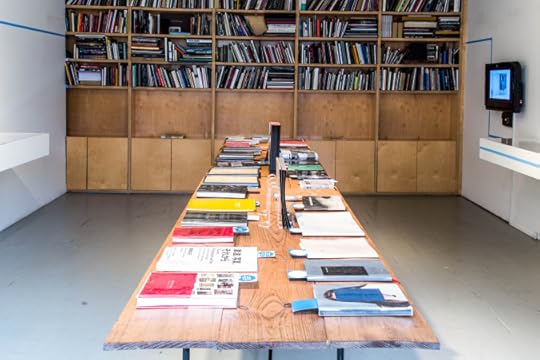





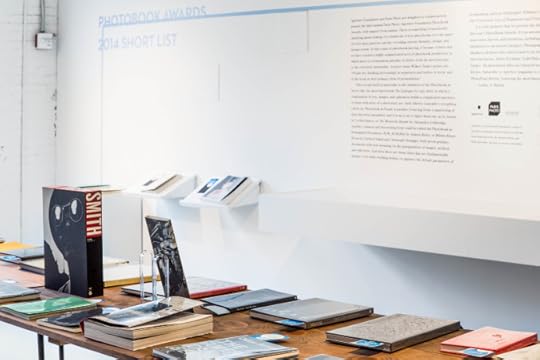



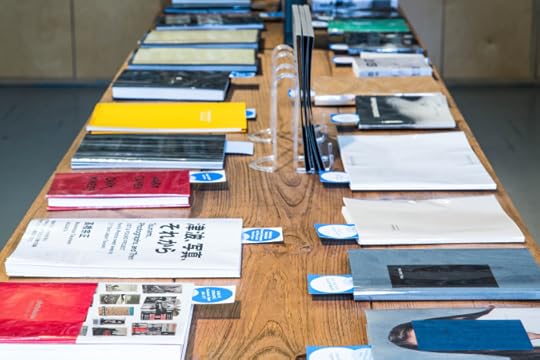

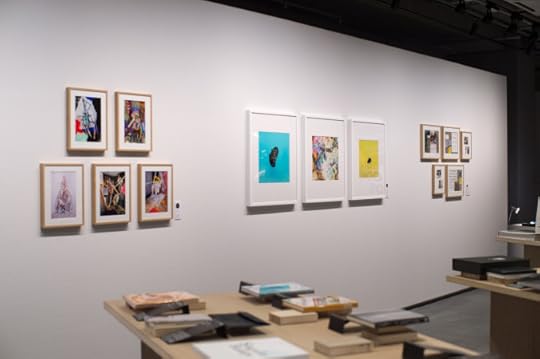


The following images courtesy IMAgallery, Tokyo



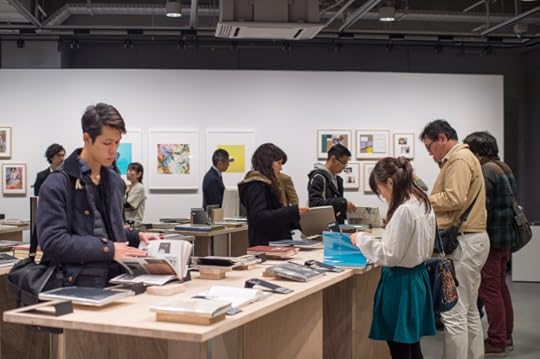





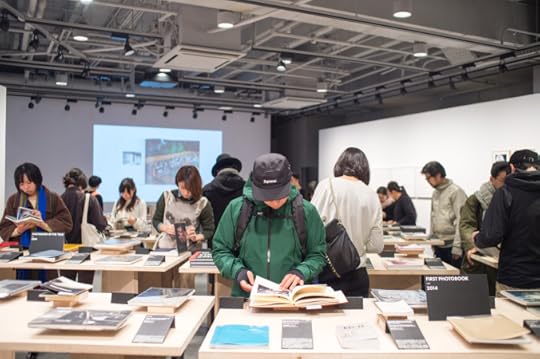
The 2014 Paris Photo–Aperture Foundation PhotoBook Awards Short List is now on view at two exhibitions, in New York and Tokyo. The New York presentation at Aperture Gallery opened December 13 and will remain on view until January 29, while a simultaneous exhibition in Tokyo at the Ima Concept Store runs through January 18. Both exhibitions offer in-depth looks at the winning titles of the Photobook Awards, given out by Aperture Foundation and the Paris Photo art fair since 2011.
Here, at Aperture’s own gallery, visitors can page through the books in a presentation in a small, intimate gallery setting, where they can also find free copies of The PhotoBook Review, Aperture’s biannual publication dedicated to the photo book, which features in-depth profiles of each listed book. At Ima Concept Store’s one-month exhibition in Roppongi, Tokyo, the 95 selected books selected for the shortlist during the past three years appear alongside a showing of prints from inside their pages. Click through the slideshow above for installation views of the Aperture exhibition, then at the Ima Concept Store.
The Paris Photo–Aperture Foundation PhotoBook Awards celebrate the photobook’s contribution to the evolving narrative of photography, with prizes in three categories. The initial short-list selection was made by Julien Frydman, director of Paris Photo;Todd Hido, photographer and photobook maker; Lesley A. Martin, publisher of the Aperture Foundation book program and of The PhotoBook Review; Mutsuko Ota, editorial director ofIMA magazine; and Anne Wilkes Tucker, photography curator at the Museum of Fine Arts, Houston. The short list was first announced by Hido at NY Art Book Fair on September 26, 2014.
The post The 2014 Paris Photo–Aperture Foundation PhotoBook Awards Exhibitions appeared first on Aperture Foundation NY.
January 13, 2015
Gordon Parks “Back to Fort Scott” Opens at MFA Boston


Gordon Parks, Husband and Wife, Sunday Morning, Detroit, Michigan, 1950. Courtesy and © The Gordon Parks Foundation. Courtesy Museum of Fine Arts, Boston.


Gordon Parks, Untitled, Columbus, Ohio, 1950. Courtesy and © The Gordon Parks Foundation. Courtesy Museum of Fine Arts, Boston.

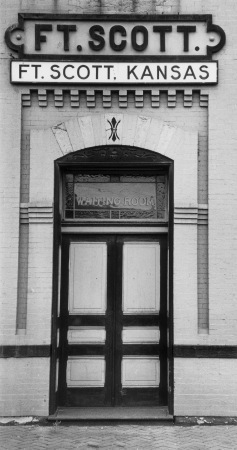
Gordon Parks, Railway Station Entrance, Fort Scott, Kansas , 1950. Courtesy and © The Gordon Parks Foundation. Courtesy Museum of Fine Arts, Boston.


Gordon Parks, Untitled, Chicago, Illinois, 1950. Courtesy and © The Gordon Parks Foundation. Courtesy Museum of Fine Arts, Boston.


Gordon Parks, Untitled (Outside the Liberty Theater), 1950. Courtesy and © The Gordon Parks Foundation. Courtesy Museum of Fine Arts, Boston.

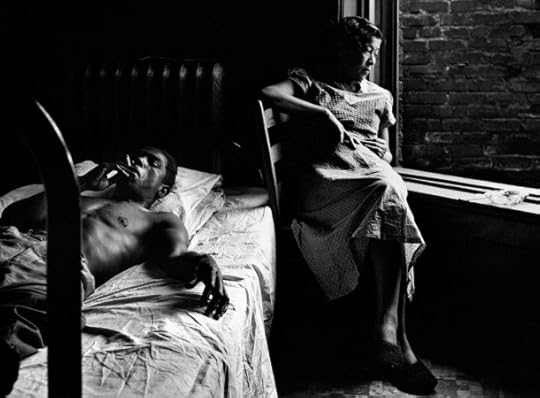
Gordon Parks, Tenement Dwellers, Chicago, Illinois , 1950. Courtesy and © The Gordon Parks Foundation. Courtesy Museum of Fine Arts, Boston.
An exhibition of photographs by Gordon Parks at the Museum of Fine Arts, Boston, revisits a highly personal, yet never-published photo essay he developed for LIFE magazine in 1950. In 1948, LIFE assigned Parks, the magazine’s first African-American photographer to be hired full time, to do a story about segregation in American education. Parks centered on what happened to his former friends and classmates at the all-black grade school in Kansas he had attended. The results were intimate portraits of African-American families that had set out to cities across the Midwest—Chicago, Detroit, and Columbus, Ohio—as well as scenes of small-town life from where Parks grew up nearly twenty years prior. (The story, however, never ran, for reasons still unknown.) The premise lends the exhibition, which opens this Saturday, its title: “Back to Fort Scott.”
The idea for the exhibition developed when Lane Curator of Photographs Karen Haas realized that the date on a Parks photograph from the museum’s collection was probably incorrect. The image, of an African-American couple standing in front of a small suburban movie theater, was dated 1949, a time when Parks was working in New York City. The Gordon Parks Foundation clued Haas in that this photograph was part of the LIFE photo essay, and suggested the idea for a highly concentrated exhibition about the project. Haas made it her goal to piece it together from the written archives in Wichita, Kansas, and the photo archives at SUNY Purchase. “The challenge was matching the pictures which aren’t identified to the memos,” Haas explained. She tried to track down any family members in the images who might still be alive, and, with the addresses she found in the archives, went on a road trip to find out if any of the actual structures in the photographs remained. “We wanted to see what buildings were standing,” she said. “We were looking for any sign of what the houses looked like.” She described Parks’s project as “a sort of modeling after American Gothic. He had this idea he would photograph these people in front of their houses, not as people in dire straits.” But as Haas found out, none of the original homes remain, as demographics have shifted dramatically in the decades since the series was shot.
“My dream is that people will see their photographs, or photographs of friends and we may find some of these people and they’ll be able to tell their story,” Haas said. “That someone will come forward and say, ‘I’m that boy, or that little girl.’”
“Back to Fort Scott” runs through September 13 at the Museum of Fine Arts, Boston. A concurrent exhibition titled “Segregation Story” runs at the High Museum of Art, Atlanta, through June 7.
The post Gordon Parks “Back to Fort Scott” Opens at MFA Boston appeared first on Aperture Foundation NY.
January 9, 2015
Aperture Magazine Live at the National Arts Club: the Lit Issue
On Tuesday night at the National Arts Club in New York, Aperture magazine hosted three photographers who appear in the Winter 2014 “Lit.” issue of Aperture magazine—Gus Powell, Erica Baum, and Moyra Davey—as each gave a presentation on how photography harnesses the tools of language and literature in their own work. The “Lit.” issue itself was born out of a conversation with contributor David Campany about Flaubert’s influence on Walker Evans, which became Campany’s essay that appears in the magazine.
Similarly, Powell described his book The Lonely Ones, also featured in the issue, as a kind of cover album of the original 1942 book of drawings by William Steig. (The original impulse to photograph everyday scenes, too, came out of a kind of cover project of Frank O’Hara’s book Lunch Poems, as Powell experimented with photographs on his lunch break.) To him, its most compelling image was that of a ripped-up letter at a mailbox, subtitled, “Change of heart.” “Somehow, it completely gripped me,” Powell said. Like Steig, Powell said he wanted a “delivery system” that delayed the pathos or humor of an image for added effect, and so he added captions in the vein of Steig’s, but accentuated them with gatefold pages that revealed photographs underneath. “I miss you” describes a man stretching on a sunny boardwalk; “I do this on the side,” says a yellow school bus stranded in a tawny desert; “A change of heart” reveals a woman standing across the street from a mailbox.
Baum spoke about her Card Catalogue series of photographs, which zero in on the quiet, outdated modes of organizing libraries with typed or handwritten categories. Like Powell, she deploys ample humor in her work; a typewritten note on a folder in one photograph reads “Apparitions.” Of another series, Dog Ear, she explained how she composes poetic fragments out of page folds. “The material was jammed,” she said of her method, in which she reassembles the words of writers like Clarice Lispector. “It all feels like it’s talking about this process,” she added. In her Naked Eye series, she photographs the slices of images between the warped and painted pages of softcover books. “I’m trying to give you the feeling of a person in their own thoughts,” she said, noting, like Powell, how this series makes use of the delay or pause between seeing and understanding, a device perhaps more natural in literature than photography.
Davey, whose work appears on the “Lit.” issue cover, spoke of her series in which she photographed details of written materials from the lives of Mary Wollstonecraft, her daughter Mary Shelley, and Mary Shelley’s stepsister Claire Clairmont, and clustered together the close-ups of their letters and first editions, mailed and dotted with colored tape as in much of her work. In exhibition, she placed these alongside her own early photographs taken when she was the same age as the young Mary Shelley and Claire Clairmont in the featured letters. That project, she explained, led to her series Subway Writers, images of people writing on the New York subway, who she saw on her way to the New York Public Library. A writer herself, Davey’s work often skirts the literary, revealing books, passages, and her own words as narration in her video work. One image, of a book she tore in half, she revealed to have actually been inspired by an editor: “They saw my cut-up books and said, ‘You have to photograph them.'”
Find Issue #217, Winter, “Lit.” here and subscribe to Aperture magazine for future issues.
The post Aperture Magazine Live at the National Arts Club: the Lit Issue appeared first on Aperture Foundation NY.
January 7, 2015
Walker Evans & the Written Word by David Campany
The following note first appeared in Aperture magazine #217, Winter 2014, “Lit.” Subscribe here to read it first, in print or online.
How did Flaubert, Baudelaire, Proust, and other writers inform the creator of “documentary-style” photography?
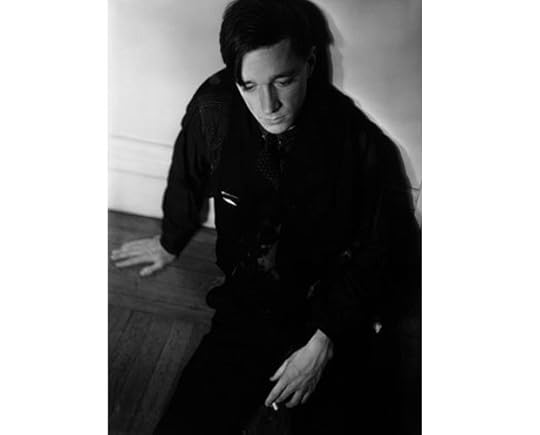
Walker Evans, Self-Portrait Seated on Floor Against Wall with Dark Cloth Around Neck, 1930–31 © Walker Evans Archive, The Metropolitan Museum of Art via Art Resource, New York
Of all the various practices of photography—advertising, industrial imaging, family albums, and the rest—it is perhaps photojournalism that brings together word and image most often and most necessarily. Usually it involves two people—a photographer and a writer—collaborating, ideally. Sometimes the photographer writes, but this is less common than the writer who photographs. In an economic climate that is challenging for photojournalism (to put it mildly) it seems easier to get a writer to photograph than it is to get a photographer to write. But there have been a handful of individuals who wanted and were able to do both. One of the most remarkable was Walker Evans.
Evans’s first calling was the written word. At college he studied French literature and was an avid reader of the cutting- edge literary journals of the 1920s, when fussy Victorian prose was giving way to the lucid and fragmentary language of modern life, and James Joyce and T.S. Eliot were idolized. During a year in Paris (1926–27) Evans also read Flaubert, Baudelaire, Proust, and others. He attempted to write, in the form of short and intense prose pieces, but the ambition was crushing: “I wanted so much to write that I couldn’t write a word,” he recalled at the end of his career. Returning to New York in 1927, he sensed the camera might offer the descriptive and expressive power that had eluded him in words, but he never lost the desire to write.
In August 1929, at the age of twenty-five, Evans was first published. A new magazine titled Alhambra carried two unrelated contributions: a typically modernist photograph of soaring cranes constructing the Lincoln Building on Manhattan’s East 42nd Street, and an accomplished translation from the French of an extract of Moravagine (1926), Blaise Cendrars’s delirious novel about a psychotic killer. Evans’s image was too deferential to
the city’s spectacle but Cendrars’s language came close to the frank but equivocal description that would come to define Evans’s photography.
While perfecting what he came to call “documentary-style” photography, Evans produced sequences of images to sit along- side texts by other writers: Carleton Beals’s political exposé The Crime of Cuba (1933), the experimental journalism of James Agee’s Let Us Now Praise Famous Men: Three Tenant Families (1941), and Karl Bickel’s documentary travel book The Mangrove Coast: The Story of the West Coast of Florida (1942). Rather than being smoothly integrated in the manner of populist books and mainstream magazines, in each case Evans’s images sat apart from the text, obliging the reader–viewers to actively negotiate their own response.
Evans did take commissions from magazines, and sometimes this led to interesting work. In 1937 Fortune magazine published “Six Days at Sea,” Evans and James Agee’s sly observation of a tourist cruise to Havana (an assignment conducted entirely incognito). Evans worked with the journalist Katherine Hamill to produce a report on slum clearance and social housing in 1939 for Harper’s Bazaar. In 1943 he landed a job as a writer at Time, reviewing films, books, and exhibitions. Agee was on the staff, as were James Stern and Saul Bellow. With a little help from Agee, Evans soon mastered Time’s concise, urbane, and witty house style. He drew readers’ attention to gems of popular culture and obscure treasures: the Krazy Kat cartoon strip, children’s art, the little-known sculptures of Edgar Degas, Winston Churchill’s paintings, anatomical drawings, and self-portraits.
Two years later Evans became the only staff photographer at Fortune. This offered the chance to get more involved in the form his work might take on the page. But the real breakthrough came in 1948 when he was made Fortune’s special photographic editor. Part of his task was to advise on the magazine’s visual style, but in answering directly to the managing editor rather than the art director, Evans was able to set his own assignments. With a degree of autonomy unheard of in magazines before or since, he would shoot, edit, write, and design his pages.

Opening page from “The Pitch Direct,” Fortune, October 1958
To accompany his photographs Evans cultivated a style of writing that was rich in rhetorical flourish, vernacular expressions, literary quotations, obscure historical references, pithy facts, and adjectives of baroque splendor. There were also moments of high polemic. Although these texts were rarely longer than a few hundred words, he crafted them tirelessly. He also kept a close eye on the typesetting, with a poet’s sensitivity to the placement of line breaks. In a 1971 interview, he recalled: “The writing wasn’t easy for me to master. But I was determined to be my own editor, so I worked hard on it. Any test met is part of one’s development.” He understood the deep connections between photography and literature. “Photography seems to be the most literary of the graphic arts,” he reflected in his chapter written for Louis Kronenberger’s anthology Quality: Its Image in the Arts (1969). “It will have—on occasion, and in effect— qualities of eloquence, wit, grace, and economy; style, of course; structure and coherence; paradox, play and oxymoron.” Indeed, the cool sobriety of his great literary heroes had far less effect on his prose than on his photography:
I wasn’t very conscious of it then, but I know that Flaubert’s esthetic is absolutely mine. Flaubert’s method I think I incorporated almost unconsciously, but anyway used in two ways: his realism and naturalism both, and his objectivity of treatment; the non-appearance of author, the non-subjectivity. That is literally applicable to the way I want to use a camera and do. But spiritually, however, it is Baudelaire who is the influence on me.
Evans’s lifelong interest in the commonplace things that modern progress deems trivial or forgettable was thoroughly Baudelairean. In society’s rejects and refuse we may find its truth. Fortune’s ethos was to champion the new, but Evans looked to the outmoded or the enduring. Fortune celebrated the world of work; Evans reflected on unemployment or idle pleasures such as wandering. Fortune heralded steel-and-glass construction; Evans cherished endangered vernacular buildings of wood and stone that improved with age and patina. While Fortune announced the new modular office, Evans looked at reliable establishments, such as local insurance firms, run by “men who cannot possibly put in a honest day’s work while clad in a razor-sharp two hundred dollar suit of clothes.” (“Vintage Office Furniture,” Fortune, August 1953). Fortune celebrated department stores; Evans looked to the sidewalk displays of small shops.

Pages from “Imperial Washington,” Fortune, February 1952
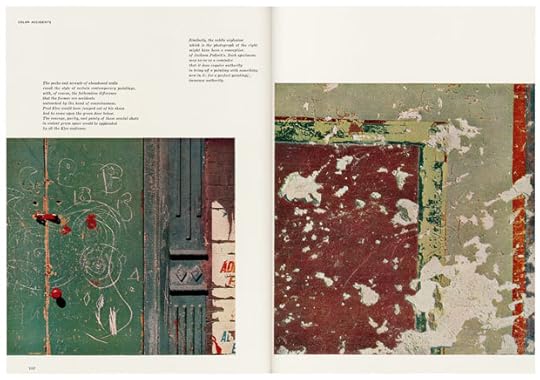
Pages from “Imperial Washington,” Fortune, February 1952
His images of everyday objects and life in the slower lane anticipated by decades the American color photographers of the 1970s (William Eggleston, Stephen Shore), while his words were ironic but affectionate. Take, for example, this from “The Pitch Direct” (Fortune, October 1958):
The stay-at-home tourist, if his eye is properly and purely to be served, should approach the street fair without any reasonable intention, such as that of actually buying something […] Does this nation overproduce? If so, one can get a lot of pleasure and rich sensual enjoyment out of contemplating great bins of slightly defective tap wrenches, coils upon coils of glinty wire, and parabolas of hemp line honest and fragrant. A man of perfectly good sense may decide after due meditation that a well-placed eggplant (2 for 27 cents) is pigmented with the most voluptuous and assuredly wicked color in the world.
At times Evans’s captions would deliberately change the meaning of, or undermine, his pictures. His article “Imperial Washington” (Fortune, February 1952) resembles a simple tourist’s survey of the capital’s stately architecture—which is really showbiz:
The last, large burst of classicism struck Washington as a direct result of the Chicago World’s Fair of 1893. So successful was the midwestern creation in plaster that its chief architects and planners moved on to the capital almost to a man and forever froze the face of the city into its Roman Renaissance expression.
Across the 1950s and ’60s Evans’s photography grew increasingly Flaubertian—simple, direct, and incisive, while his words grew poetic and arch. To do it the other way around, with plain text introducing florid images, would risk pretention, like a gallery of grandstanding pictures. The last thing Evans wanted for his magazine pages was Art. He was making resistant journalism, countering the values and conventions of the mainstream. He produced more than forty photo-essays for Fortune and several for other titles. “Color Accidents” (Architectural Forum, January 1958) was a suite of square compositions picked out from weathered walls of a New York street. The writing compares but distances them from abstract painting, then at its popular height:
The pocks and scrawls of abandoned walls recall the style of certain contemporary paintings, with, of course, the fathomless difference that the former are accidents untouched by the hand of consciousness. Paul Klee would have jumped out of his shoes had he come upon the green door below.
Evans’s photographs of these colors and marks are consummate formal exercises. However, the text suggests that what’s important are the walls themselves and that his photographs are, in the first instance, documents of things worth noticing in the world. These were not pictures for exhibition: they were elegant reports fashioned for the page.

Pages from “Faulkner’s Mississippi,” Vogue, October 1948
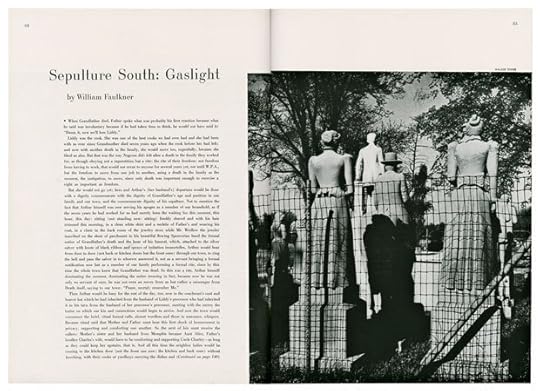
Opening pages from William Faulkner’s “Sepulture South: Gaslight,” Harper’s Bazaar, December 1954
At times Evans’s love of literature became explicit. In 1948 he was commissioned by Vogue to photograph the Southern landscape depicted in the novels of William Faulkner. He admired the writer, who was about to break six years’ silence with the publication of Intruder in the Dust. Faulkner’s novels were set in the fictional Yoknapatawpha County, so, strictly speaking, it could not be photographed. Evans’s languid and haunting six-page response is almost devoid of people. A cemetery, rail tracks, wood-frame houses, shacks, and fading mansions—these are spaces where something has or could happen, as if each photograph might preface a chapter.
Evans does something similar with “The U.S. Depot” (Fortune, February 1953), in which a survey of single-building railroad stations seems more like a set of locales for short stories once we read the introductory paragraph. “And what is on that green-paper note handed up on its looped stick to the engineer as the 3:52 brakes to a stop? Does it say ‘Train five Engine eight four nine six delayed at Millerton hot journal box,’ or does it say ‘Tell Jeanie I’ll get pork chops’?”
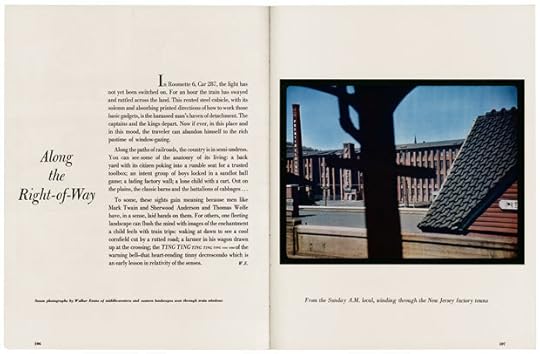
Pages from “Along the right-of-Way,” Fortune, September 1950 Metropolitan Museum of Art, New York
The following year, 1954, Faulkner saw a photograph by Evans of a cemetery plot (Woodbridge Family Monument, Mansfield, Kentucky, 1945), inspiring him to write the short story “Sepulture South: Gaslight.” It was published in Harper’s Bazaar alongside the imposing image. It’s a Proustian remembrance, part fact, part fiction, of the funeral of Faulkner’s grandfather. The narrator returns to the gravestones, “stained now, a little darkened by time and weather and endurance, but still serene, impervious, remote, gazing at nothing, not like sentinels, not defending the living from the dead by means of their vast ton-measured weight and mass, but rather the dead from the living ….” Seen from the rear, Evans’s stone family now appears to be turning away from time itself.
Evans’s enduring reputation, endorsed by museums world- wide, is that of an artist operating in the guise of a documentarian. His magazine work complicates this casting. It is clear he was interested in making independent and resistant photojournalism that really only worked when image, text, and design came together on the page. A photojournalist can, of course, be informed by art and literature. Such influences certainly made Evans’s work better. The finest illustration is perhaps “Along the Right-of-Way,” an eight-page piece from 1950 on the simple pleasures of gazing from train windows. The opening photograph is as good as any painting by Edward Hopper or Charles Sheeler. And his text is a minor miracle of reported fact, remembrance, suggestion, allusion, flight of fancy, and even physics. All in three short, sublime paragraphs.
_____
David Campany is a writer and curator. He teaches at the university of Westminster, London, and recently published Walker Evans: The Magazine Work with Steidl. Campany’s The Open Road: Photography and the American Road Trip was published by Aperture this fall.
The post Walker Evans & the Written Word
by David Campany appeared first on Aperture Foundation NY.
January 2, 2015
Genevieve Allison on Martin Schoeller at Hasted Kraeutler
By Genevieve Allison


©Martin Schoeller, Cate Blanchett; Universal City, CA , 2006. Courtesy of Martin Schoeller/AUGUST


©Martin Schoeller, Cesar Millan with his Dogs; South Central Los Angeles, CA , 2006. Courtesy of Martin Schoeller/AUGUST

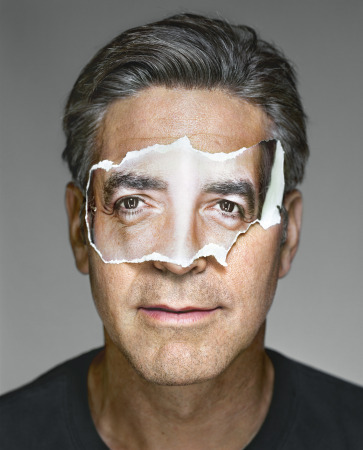
©Martin Schoeller, George Clooney with Mask; Brooklyn, NY , 2008. Courtesy of Martin Schoeller/AUGUST

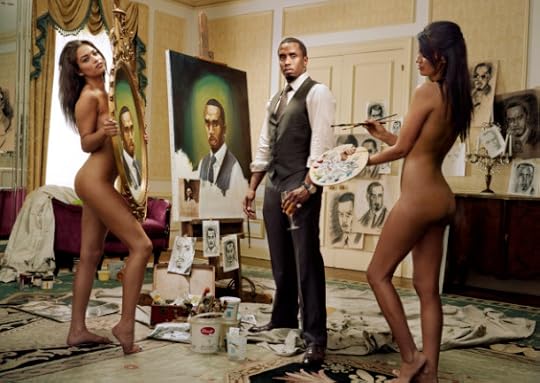
©Martin Schoeller, Sean Combs Painting; New York, NY, 2010. Courtesy of Martin Schoeller/AUGUST

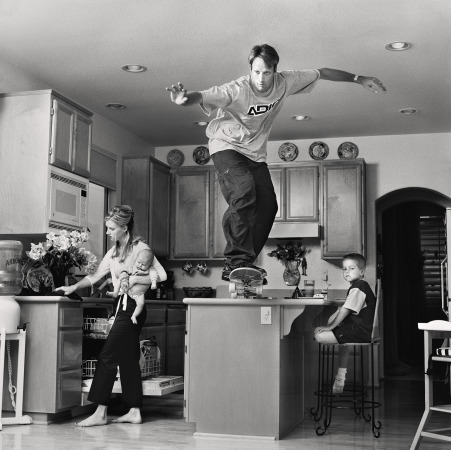
©Martin Schoeller, Tony Hawk with his Family; Carlsbad, CA, 1999. Courtesy of Martin Schoeller/AUGUST
If, according to Charles Dickens, there are only two genres of portraiture, the serious and the smirk, then both exist conterminously in each of the 30 large-format archival pigment prints presented in “Portraits,” a major retrospective of Martin’s Schoeller’s photographs. His bold style of portraiture, cultivated over more than a decade as a staff photographer for the New Yorker, can be direct and penetrating or canny and constructional—or all, at the same time. Excluding works from famed series such as “Twins” and “Female Body Builders,” the exhibition instead concentrates on his celebrity portraits, which expose a more playful side of his practice. Jay Z, Bill Murray, and George Clooney are just a few notable examples of stars who have sportively sat for the German-born artist’s sensational, but not-always flattering pictures.
Whimsical pictures of the very famous prepossess appeal but seldom are they realized with Schoeller’s flare for exposing the undercurrents of a personality. This is achieved most subtly and poignantly in the black-and-white photographs he has reproduced from his commercial career, which tend to be more sober and documentary [documentarian/?] yet express his talent in bringing out the character of the sitter, not just with subtleties of lighting or the choice of attitude and expression, but by an artfully struck balance of candidness and staging. In one particularly striking image, Bill Clinton appears chipping putts in the Oval Office with a facial expression that in that exquisite moment betrays equal volumes of calculation and bonhomie. Such pictures exemplify the artist’s preference for capturing moments of unmannered repose, when the sitter isn’t acutely aware that he or she is still being photographed.
In more staged portraits, the quality of honesty turns on what can be an unforgiving focus when it comes to matters of the finer topographical details of the face. His gossamer lens captures everything in its presence with intimacy and suspension– even the most discreet articulation of the skin.This might not be as apparent with youthful subjects like Little Kim and Lady Gaga, but discerning head shots of Brad Pitt and Johnny Cash so intently describe the aging male form that, initially, they suggest a meditation on retiring beauty or power– or at least of a truthfulness in its depiction. And certainly this theme appears again in the mutually striking yet contrasting pictures of Clint Eastwood and Geoffrey Rush: Eastwood is braced and unflinching, Rush resigning and impassive.
Despite the aforementioned and the potential for reading emotional responses between the sitter and picture taker, Schoeller’s approach to his subjects is characterized by a sense of fun and unyielding proximity, not sentimentality. This can be perceived in every aspect of production– from the mood achieved by his direct, hyper-lit gaze to the eccentrically conceived narrative devices he tailors to each character. The set designs and props work for the most part to impose a wry reflexivity on the subject: Marina Abramovic flanked by naked people in the subway; Steve Carrell wrapped in cellotape. What is truly remarkable and testament to Schoeller’s skill as a portraitist, are the imprimaturs of the subjects themselves, allowing fun to be made of, and from, their images.
Genevieve Allison is on the editorial staff at the Museum of Modern Art, New York.
The post Genevieve Allison on Martin Schoeller at Hasted Kraeutler appeared first on Aperture Foundation NY.
Aperture's Blog
- Aperture's profile
- 21 followers



